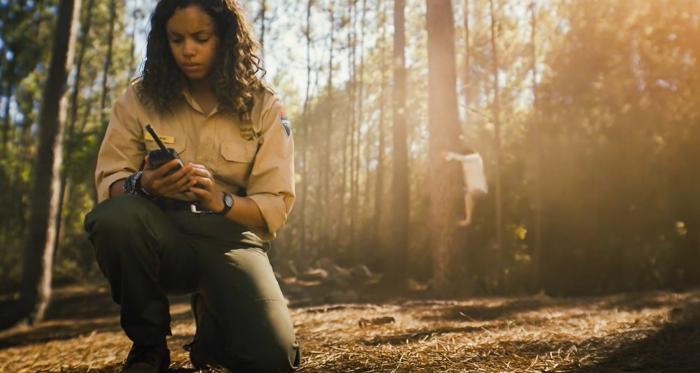By Nate Parker | Film | February 27, 2024

We’ve always known there’s something in the forest. It was more obvious to our ancestors who survived without electricity or creature comforts when the dark crept in around the edges of boarded windows and locked doors, but it’s still true. We used to leave offerings of fresh milk and the best cuts of meat, even sacrificed lives to it. Beyond the bears, wolves, and lions that make up our very rational fears of the great outdoors, there’s a sense of something more. You may have already felt it in some of the gnarled natural spaces left to us. If not, just walk into a state or national park after dark, turn off all your lights, and listen to the forest breathe around you. Feel its eyes on you. If you’re lucky, you won’t be one of the many hikers who vanish without a trace.
National Park Service employee Lennon (Georgina Campbell, Barbarian) thinks she knows this better than most. An inexperienced ranger who previously only led tours of day hikers close to civilization, this is her first year working the Arvores Park backcountry. She’s spent enough time fighting for the position to raise eyebrows among her coworkers. The fact Lennon’s 5-year-old sister was lost in those woods years before doesn’t help her reputation. But Chief Ranger Zhang (Wai Ching Ho, who makes the most of her limited screen time) has decided Lennon is ready. Her backcountry “neighbor,” Ranger Jackson (Nick Blood), is willing to give her a fair chance, so Lennon is dropped via helicopter into the isolated campsite that will be her home for the next 90 days.
The days pass easily at first, despite the isolation and rough conditions. Cinematographer Rui Poças shows us a serene conifer forest with tall trees and little underbrush that could be almost anywhere in the northern US despite being filmed in Portugal. Despite her past experiences and a vague unease brought on by a few ominous signs, Lennon quickly falls into a routine of patrols, camping, and solitude. But as the end of her shift draws near, her reverie is shattered by the sudden appearance of an injured and panicked hiker whose partner has vanished without a trace. Lennon calls in a search-and-rescue team but then defies orders and tracks down the missing hiker herself. What follows is a hallucinatory journey into the forest brought on by exposure, exhaustion, head trauma, and perhaps something more sinister.
Lovely, Dark, and Deep is writer/director Teresa Sutherland’s first feature effort, but she does an excellent job weaving together a tale of increasing paranoia and unseen threats in the great outdoors that more than once succeeded in raising the hairs on my arms. Abrupt location changes and scenes of quiet horror that play out in natural daylight lend a surreal quality to the film’s second and third acts, and Campbell’s subtle facial expressions clue us in to her disquiet long before the deer poop hits the fan. We’re left to put together Lennon’s past from flashbacks and snippets of conversation, and while it’s a simple puzzle, it adds nicely to the overarching mystery. The body horror is sparing but effective, and here again Sutherland uses the natural world and light to her advantage. Cues pay off, and if it weren’t for a disappointing shift in location and too much exposition in the finale, I’d consider the movie a complete success.
As it stands, Lovely, Dark, and Deep is still a great watch. Progressively creepier and more disjointed, the gorgeous visuals and excellent sound direction add plausibility to Lennon’s fever dream. Promos describe the film as cosmic horror, but I’d argue it’s the opposite. The hidden beings roaming our most natural spaces were here long before we climbed out of the trees, and after we’re gone will reclaim the spaces colonized by monkeys with delusions of grandeur. Here’s hoping I’m dead before they do. Lovely, Dark, and Deep is currently available to rent or own on Prime and other streaming services.